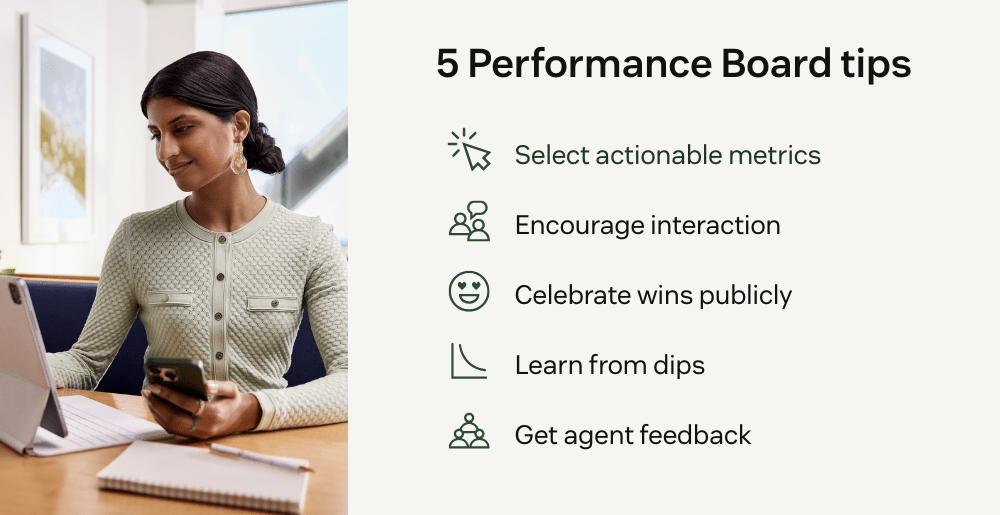Article • 4 min read
It’s time to rethink accountability for service teams
Accountability can be used to control or it can promote collaboration and cohesion among teams. You choose.
Última atualização em August 12, 2025
Too often, customer and employee service leaders mistake accountability for policing—a way to catch mistakes and enforce rigid rules. As a result, tracking agent performance has become a form of micromanagement rather than what it should be: a powerful driver of trust, motivation, and growth.
For decades, traditional approaches to performance management have bred apprehension and disengagement. By focusing too heavily on metrics like handle time, schedule adherence, and occupancy rates, teams are judged on whether they meet numbers, not the value they bring to troubleshooting issues and finding ways to improve. This punitive culture harms morale and raises turnover—pricey since replacing a service agent can cost up to 200% of their annual salary.

Accountability can be a means to control or it can promote collaboration and cohesion among teams. Zendesk’s Workforce Management (WFM) Performance Boards helps to promote buy-in at all levels by boosting transparency and alignment on goals. With better visibility on real-time metrics, agents can own their success by truly understanding their impact, managers can guide and celebrate wins in real time, and teams can truly work as one to deliver better support.
How Performance Boards fuel transparency, engagement, and impact
When accountability is done the right way, it can unlock both cultural and business value. Admins can make more proactive, strategic decisions. Agents feel supported and capable. Teams become more resilient and adaptive.
Here’s how Zendesk WFM Performance Boards create an accountability culture that promotes better outcomes for teams:
1. Boost transparency and buy-in among teams
Modern performance dashboards, especially those built into Zendesk WFM, are fundamentally different in that they give agents direct visibility into their own KPIs and trends, rather than locking key metrics behind managerial dashboards. They’re not here so that managers can catch employees slipping. Instead, they’re meant to guide, illuminate, and enable.
Democratizing access to live performance data encourages ownership by showing how individual contributions impact team and business goals. Rather than having to wait for feedback, agents can self-correct in real time. Meanwhile, managers gain actionable insights that shift their role from policing performance to coaching for growth, allowing them to recognize successes, provide tailored guidance, and build trust through supportive, motivating conversations.
2. Empower teams without fear
Transparent performance boards can help boost psychological safety by creating a workplace environment where team members feel free to discuss progress, bring up challenges, and seek help without worry of blame or punishment. Studies have found that psychological safety enhances team learning behaviors and efficacy, which together mediate improved team performance, accountability, and overall effectiveness.
Psychologically safe teams innovate and improve by openly discussing what works and using visible data for ongoing problem-solving and learning. Zendesk WFM Performance Boards support this by normalizing performance fluctuations and refocusing attention on long-term trends rather than isolated shortcomings. As a result, accountability is experienced as a supportive framework for growth, rather than a punitive measure of performance.
3. Increase engagement and overall success
Research shows that employee engagement greatly influences organizational success. Engaged employees are significantly more productive, more loyal, and more likely to deliver exceptional service. Highly engaged teams also outperform their peers by more than 200%.
Zendesk WFM Performance Boards provide clear, real-time feedback that helps agents better understand their work and how it impacts key metrics. These always-on insights keep agents regularly engaged and invested in performance, not just during review periods.
5 ways to use Performance Boards as tools for positive growth
Embracing a people-first approach to accountability may feel good, but it also works. Zendesk customers who’ve embraced a transparent and empowering approach to performance management often see lower attrition rates, improved performance, and better customer and employee outcomes.

Here are five ways to use Performance Boards to create a more empowering culture of accountability for your team:
1. Select actionable and understandable metrics:
Set goals with each metric and provide clear context explaining why each metric matters. For example, explain how “adherence” impacts customer wait times or why “resolution time” correlates with CSAT scores.
2. Encourage regular interaction:
Use Performance Boards as active coaching tools, integrated into daily standups, and 1:1 conversations. Engage agents in reviewing their own data and identifying patterns to cultivate autonomy.
3. Celebrate wins publicly:
Recognize top performers and team milestones in real time to boost morale and reinforce intrinsic motivation.
4. Use dips as learning opportunities:
Approach performance dips as moments for exploration, where agents and managers collaboratively identify root causes and develop action plans instead of assigning blame.
5. Solicit agent feedback continuously:
Invite agents to share insights about what support they need and what strategies are working for them. This builds a feedback-positive culture.
Let’s make performance a team sport
Accountability shouldn’t be a scary word, and with Zendesk WFM Performance Boards, it doesn’t have to be. By shifting focus from managing metrics to motivating people, performance becomes a collaborative, data-driven effort.
Agents take ownership of their performance, make informed decisions in the moment, and clearly understand how their work contributes to larger organizational goals. The result is a culture of trust and continuous growth—one where teams are aligned, engaged, and working toward shared success.
Learn more about the Zendesk WFM Performance Boards below:
